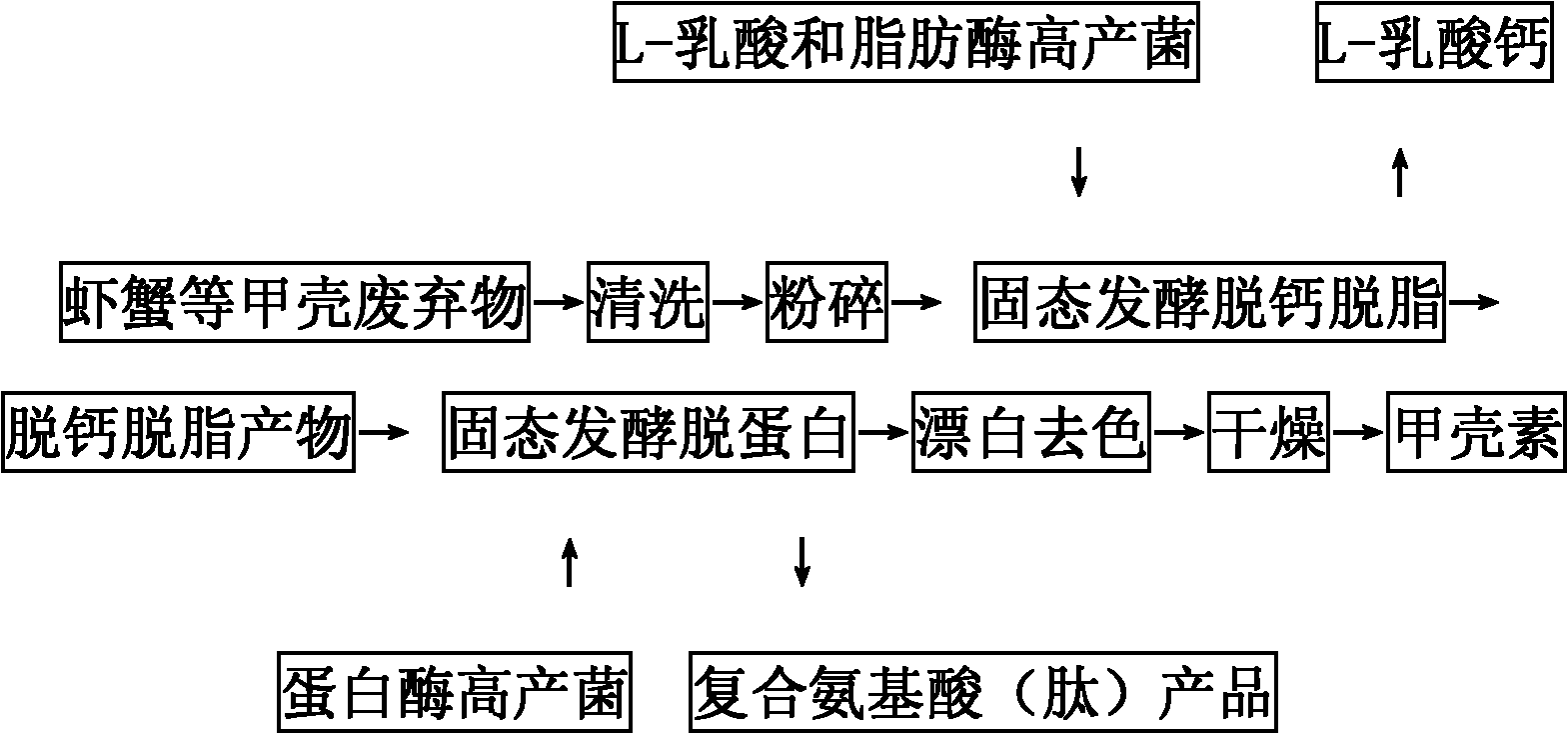Method for preparing chitin, L-calcium lactate and compound amino acid or peptide from carapace waste
A waste, chitin technology, applied in biochemical equipment and methods, microorganism-based methods, microorganisms, etc., can solve the problems of low calcium salt removal rate, low acid production rate, high cost, and achieve high decalcification rate. , the effect of high purity
- Summary
- Abstract
- Description
- Claims
- Application Information
AI Technical Summary
Problems solved by technology
Method used
Image
Examples
Embodiment 1
[0025] Example 1 Preparation of chitin from crustacean waste such as shrimp and crab
[0026] 1. Clean production process and parameters
[0027] 1) Cleaning of crustacean waste such as shrimp and crab: clean the soil and other dirt on the crustacean waste such as shrimp and crab with tap water, dry and pulverize;
[0028] 2) Grinding fineness: 20-60 mesh.
[0029] 2. Solid-state fermentation decalcification and degreasing of crustacean waste
[0030] 1) Cultivation of Lactobacillus rhamnosus and Bacillus subtilis seeds
[0031] 1.1) Lactobacillus rhamnosus culture medium
[0032] A, composition of slant activation medium (g / 100ml): peptone 1%, beef extract 1%, yeast extract 0.5%, glucose 2%, diammonium hydrogen citrate 0.2%, potassium dihydrogen phosphate 0.2%, Tween 800.1% , magnesium sulfate 0.058%, manganese sulfate 0.025%, sodium acetate 0.2%, agar 2%, calcium carbonate 0.6%, sterilized at 115°C for 30min, pH 6.4.
[0033] B. Composition of liquid seed medium (g / 100m...
Embodiment 2
[0066] Example 2 Preparation of L-calcium lactate, compound amino acids or peptides from crustacean waste such as shrimp and crabs
[0067] 1. Clean production process and parameters
[0068] 1) Cleaning of crustacean waste such as shrimp and crab: clean the soil and other dirt on the crustacean waste such as shrimp and crab with tap water, dry and pulverize;
[0069] 2) Grinding fineness: 20-60 mesh.
[0070] 2. Solid-state fermentation decalcification and degreasing of crustacean waste
[0071] 1) Cultivation of Lactobacillus rhamnosus and Bacillus subtilis seeds
[0072] 1.1) Lactobacillus rhamnosus culture medium
[0073] A, composition of slant activation medium (g / 100ml): peptone 1%, beef extract 1%, yeast extract 0.5%, glucose 2%, diammonium hydrogen citrate 0.2%, potassium dihydrogen phosphate 0.2%, Tween 800.1% , magnesium sulfate 0.058%, manganese sulfate 0.025%, sodium acetate 0.2%, agar 2%, calcium carbonate 0.6%, sterilized at 115°C for 30min, pH 6.4.
[0074] ...
PUM
| Property | Measurement | Unit |
|---|---|---|
| skim rate | aaaaa | aaaaa |
Abstract
Description
Claims
Application Information
 Login to View More
Login to View More - R&D
- Intellectual Property
- Life Sciences
- Materials
- Tech Scout
- Unparalleled Data Quality
- Higher Quality Content
- 60% Fewer Hallucinations
Browse by: Latest US Patents, China's latest patents, Technical Efficacy Thesaurus, Application Domain, Technology Topic, Popular Technical Reports.
© 2025 PatSnap. All rights reserved.Legal|Privacy policy|Modern Slavery Act Transparency Statement|Sitemap|About US| Contact US: help@patsnap.com

